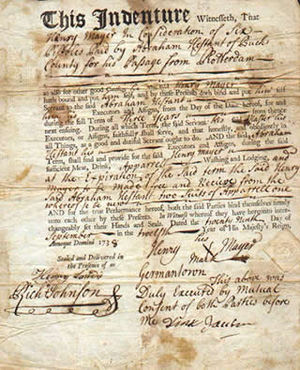
Back Treballador no abonat Catalan Smluvní služebník Czech Indentur German Nepagita servisteco Esperanto Trabajador no abonado Spanish Engagisme French משרת חוזי HE Servitù debitoria Italian 年季奉公 Japanese 계약 하인 Korean

| Part of a series on |
| Forced labour and slavery |
|---|
 |
Indentured servitude is a form of labor in which a person is contracted to work without salary for a specific number of years. The contract called an "indenture", may be entered voluntarily for a prepaid lump sum, as payment for some good or service (e.g. travel), purported eventual compensation, or debt repayment. An indenture may also be imposed involuntarily as a judicial punishment. The practice has been compared to the similar institution of slavery, although there are differences.
Historically, in an apprenticeship, an apprentice worked with no pay for a master tradesman to learn a trade. This was often for a fixed length of time, usually seven years or less. Apprenticeship was not the same as indentureship, although many apprentices were tricked into falling into debt and thus having to indenture themselves for years more to pay off such sums. [citation needed]
Like any loan, an indenture could be sold. Most masters had to depend on middlemen or ships' masters to recruit and transport the workers, so indentureships were commonly sold by such men to planters or others upon the ships' arrival. Like slaves, their prices went up or down, depending on supply and demand. When the indenture (loan) was paid off, the worker was free but not always in good health or of sound body. Sometimes they might be given a plot of land or a small sum to buy it, but the land was usually poor.